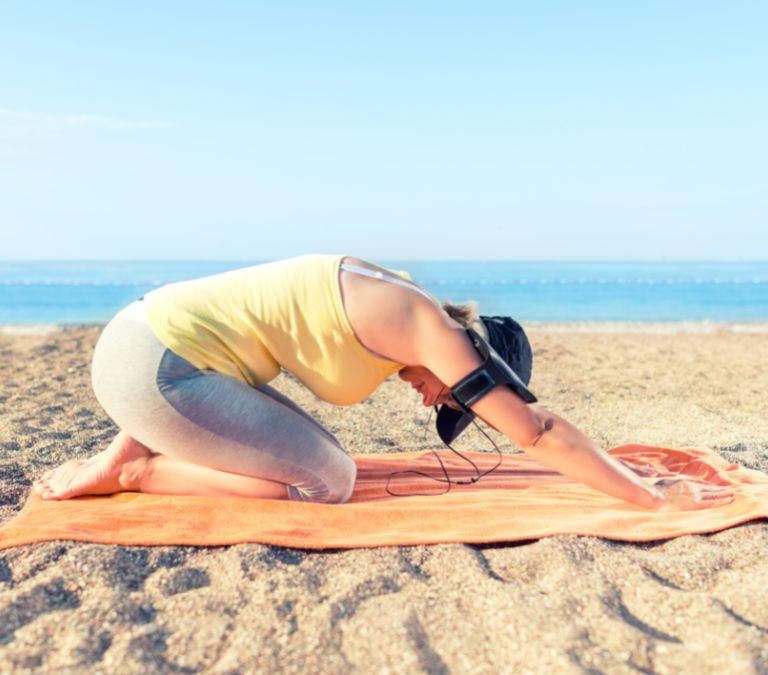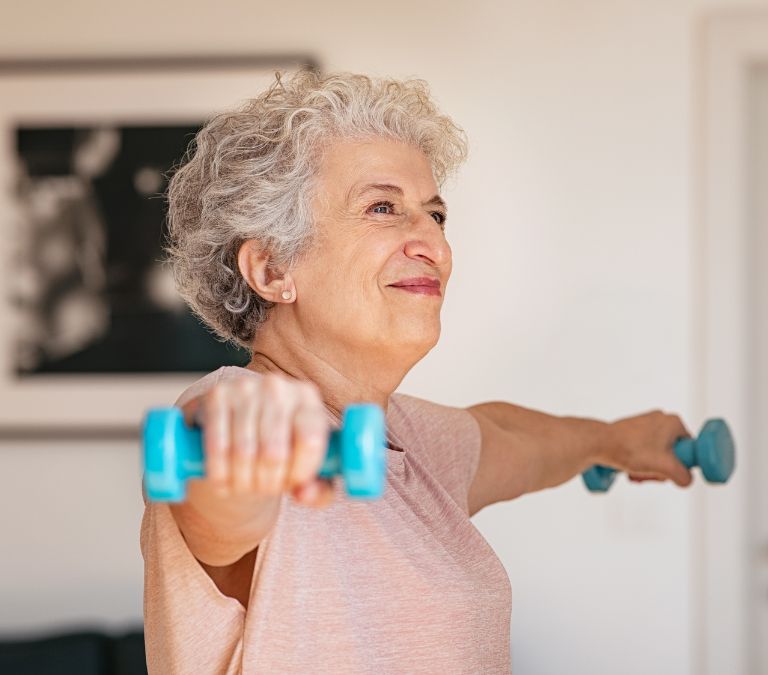The lack of estrogen production by the ovaries can cause alterations at the pelvic floor level that can affect the quality of life of women. According to the AEM, 20-50% of women aged 45-65 suffer from urinary incontinence. Kegel exercises are the solution to the pelvic floor during menopause.
Most women notice that their periods are more irregular in their late forties and early fifties. This fact is due to menopause, an event in women’s lives in which significant hormonal changes affect many aspects of health.
What Happens to the Body during Menopause?
According to the Spanish Association for the Study of Menopause (AEEM), around 85% of women after menopause suffer a deterioration in their quality of life. In fact, during the beginning of this hormonal change, women may experience alterations in their genital organs and the bladder, loss of collagen, osteoporosis, increased cardiovascular risks, and alterations in their psychological state.
Also, the increased dryness of the vagina, the loss of elasticity, and the reduction of the vaginal canal during menopause cause decreased sensitivity during sexual intercourse, anorgasmia, or loss of sexual appetite.
In addition to all these consequences, the lack of estrogen production by the ovaries can cause alterations at the level of the pelvic floor that can affect the quality of life of women: urinary incontinence – according to the AEEM, in the age range of 45 to 65 years old, 20-50% suffer from it-, prolapses – the descent of one of the pelvic organs that a weakened pelvic musculature cannot hold-, and fecal incontinence.
What are Kegel exercises? How are they performed?

These exercises, created by Dr. Arnold Kegel in 1940, consist of contracting the pelvic floor muscles up and in for a few seconds to strengthen and tone the pelvic muscles. Experts assure that “doing these exercises is essential to recover after childbirth, prevent incontinence and increase sexual desire, as well as better cope with the problems arising from menopause .”
Kegel exercises can help strengthen the muscles below the uterus, bladder, and (large) intestine. They can help men and women with urine leakage or bowel control problems. You may have these problems:
- As you get older
- if you gain weight
- After pregnancy and childbirth
- After gynecological surgery (women)
- After prostate surgery (men).
Kegel exercises are done anytime you are sitting or lying down. You can do them when eating, sitting at your desk, driving, resting, or watching TV.
A Kegel exercise is like pretending to urinate and then holding back. You relax and tighten the muscles that control the flow of urine. It is essential to find the correct muscles to tighten.
Incontinence during Menopause and Kegel Exercises as a Solution
According to the National Institute of Statistics, more than 3 million Spanish women are suffering from the symptoms of menopause. The subject of this post is not isolated or rare: Approximately 80% of patients who face this stage in their lives have symptoms of urinary incontinence.
Urine loss in menopause is a nuisance that goes far beyond the well-known hot flashes, insomnia, or loss of sexual desire, and that ends up having a significant impact on a woman’s life.
So what impacts does menopause have on your life?
Menopause and Urinary Incontinence at the Physiological Level
Especially in early menopause (45 to 55 years), the decrease in estrogen levels produces numerous symptoms. Hot flashes, increased sweating, palpitations, or digestive problems such as constipation or gas may appear to a greater or lesser degree.
But the arrival of menopause also comes with other associated problems, such as increased vaginal dryness, weight changes, and a greater tendency to osteoporosis.
As I have told you other times, urinary incontinence can have physiological causes, such as when the bladder and pelvic floor are damaged or weakened for various reasons (childbirth, sports, age), causing annoying urine loss in women: It’s about stress incontinence.
But in the case of urge incontinence, the losses come from the changes that the female body experiences during menopause. And it is that the decrease in female hormones causes atrophy of the vaginal tissue, and the circulation of the area is altered, causing, in some cases, the loss of voluntary control of the bladder and, with it, these urine losses in menopause.
Menopause and Urinary Incontinence at the Mental Level
And it is that with a negative attitude towards changes, the only thing you will achieve is to increase some of the symptoms.
For example, it is expected that with the hormonal changes of menopause, there is a drop in libido and sexual desire. Still, if you have high self-esteem and good communication with your partner, you will surely overcome that moment and even become stronger.
Some negative things are associated with menopause; however, dare to turn the situation around! An enthusiastic and positive attitude will make you perceive this stage as an exciting challenge that is important to live fully.
Kegel Exercises as the Solution

The Kegel method is named after its inventor, Dr. Arnold Kegel, who in the 1940s began recommending this method to his patients for urinary continence.
The Kegel method may also be known as “pelvic floor strengthening exercises” or “pelvic floor exercises. “
The goal of the Kegel Method
The main objective of the Kegel method is to work and strengthen the pelvic floor muscles. It will result in a substantial improvement in the functioning of the urethral sphincter, leading to a decrease in urine loss.
The Kegel method can help both women and men.
Causes of Urinary Incontinence
The leading cause of urinary incontinence is aging.
In addition, other important causes can be:
Complicated deliveries or with giant babies. If the delivery is vaginal, there is a greater chance of suffering from urinary incontinence.
Exercising, carrying weights, and playing sports in the postpartum stage also help suffer urinary incontinence.
Obesity.
Chronic cough.
Constipation.
Work involving the lifting of heavy loads. Menopause, which is due to hormonal changes, weakens specific muscles. Play wind instruments and even practice singing.
In general, the causes listed above cause the structure of the pelvic organs to weaken, and they move outwards. This displacement is what causes urinary incontinence.
Fortunately, as with any other muscle, they can be made stronger again when these muscles get weak. In addition, the Kegel method has been shown to improve urine leakage.
Benefits of the Kegel Method
Once a simple introduction to the Kegel method has been made, we will now list the benefits of its use :
- The time interval between trips to the bathroom is increased.
- Muscle tone is restored.
- Improves sexual intercourse.
- It is possible to increase the amount of urine the bladder can store.
- Increases control over when to urinate.
- It helps prevent tears and facilitates natural childbirth.
- It can prevent organs such as the uterus and bladder from sticking out of the lower abdomen.
- No device is needed; they can be done anywhere and anytime.
- They are suitable for any age and physical condition.
- They can be done sitting, standing, or lying down.
- The Kegel method is a highly established methodology in the urinary incontinence solution, and its efficiency has been demonstrated.
- It helps pregnant women cope with the increased weight of the fetus.
- They reduce the effects of menopause on the pelvic structure.
How to Identify the Pelvic Floor Muscles
On certain occasions, if the muscles to be exercised are not well identified, it is possible that while we perform the Kegel exercises, we work on other forces, and therefore our work does not improve. For this reason, it is essential first to identify the muscles to work.
Going to your doctor or physiotherapist for this first identification is beneficial.
One possible option to identify the muscle on your own is self-palpation. Lie comfortably, bend your legs, place your index finger between your anus and vagina, and try to hold in gas or stop urinating. These muscles that you notice in tension are the ones that will have to be worked on using the Kegel methodology.
Dyspareunia
What is Dyspareunia?
Dyspareunia is a painful and repeated sensation during sexual intercourse that significantly affects relationships with the partner.
It should be noted that there are currently many types of couples, and dyspareunia is not limited exclusively to heterosexual relationships: it is a disorder that affects women, regardless of their sexual preferences.
Dyspareunia is due to different causes, and contrary to what one might think, it does not only occur in menopause but can occur at any age. However, at the time of perimenopause, changes favor its appearance, specifically the lack of estrogens that produce dryness, the fragility of tissues, and loss of lubrication.
Sexual health is closely associated with physical and mental health. Physical and psychological health problems can cause sexual dysfunction, and vice versa: sexual issues can affect physical and psychological health.
Fortunately, sexual rights are part of human rights, meaning mature people can have better quality sex for longer.
Dyspareunia makes women avoid sexual activity to avoid pain, which inevitably affects their relationships and generates psychological discomfort that affects their lives, reducing their quality of life.
Health professionals must insist that discomfort occurs typically at the stage of life in which it is considered normal. Still, patients must be informed of the current solutions, especially since we are witnessing an increase in life expectancy, greater freedom in sexual customs, and greater social acceptance of the right to sexual pleasure, which has been pointed out as a human right.
Common Causes of Dyspareunia
The most frequent causes of dyspareunia are usually:
- Surgical menopause: when the ovaries are removed for a medical reason.
- Premature ovarian failure (non-surgical early menopause).
- Postpartum and lactation.
- Radiotherapy, chemotherapy, etc.
- Autoimmune diseases.
- Vaginal infections and inflammations.
- Low-dose contraceptives and antiandrogens.
- Other drugs: serotonin reuptake inhibitors, antihistamines, and anticholinergics.
Diagnosis of Pain on Vvaginal Penetration
The symptoms of dyspareunia due to vaginal dryness vary depending on the case’s evolution. Symptoms are typically progressive and worsen over time.
- Vulvar or vaginal pain at the introitus or inside the vagina.
- Decreased vaginal lubrication during sexual intercourse.
- dryness and burning
- Vulvar or vaginal bleeding (for example, postcoital bleeding, fissures).
Urinary tract symptoms are often confused with urinary infections due to their resemblance.
Anticipatory intercourse anxiety leads to avoidance of intercourse and other sexual activities.
A complete gynecological examination needs to be performed to complete the clinical diagnosis,
We can see, among other signs, scarcity of pubic hair, decreased thickness of the lips, and in some cases, a fusion of the labia minora. In addition, it is not uncommon to see a narrowing of the introitus to the point that cracks sometimes occur in the vulvar fork, which often opens, causing pain and burning when urinating.
In these patients, it is necessary to be very careful when exploring the vagina and taking the cytology, using the speculum that adapts to the size of their genitals and lubricant to introduce it gently since there is a slight vaginal shortening and loss of folds and paleness of the mucosa.
The contact can cause pain and even bleeding in some women who have suffered from these symptoms for a long time.
Vaginismus due to Dyspareunia
When dyspareunia becomes chronic, it can end up becoming vaginismus. The woman avoids sexual activity, and her body reacts to sexual proximity as if it were a phobia that prevents her from enjoying sex and living the sexual experience with anxiety. The overall prevalence of dyspareunia varies and increases with age.
In a recent review by the World Health Organization, the prevalence of painful intercourse was between 8 and 22% percent of women.
If we talk about vaginal dryness, the prevalence varies according to the different age groups:
3% of women of reproductive age
4% of women in perimenopause
Reaching 20% in the group of the last years of transition of menopause
Almost half of them suffer from it in the three years after menopause. Sadly, all women with vaginal dryness do not consult their gynecologist, and only a third of women with dyspareunia receive treatment.
It is an issue of lack of confidence on their part, coupled with cultural beliefs, and they also have no information that there are effective treatments to solve the problem.
Finally, they resign themselves to giving up their sexual activity.
Kegel Exercises as a Solution to Dyspareunia
Curiously, some exercises made known more than 80 years ago are still practiced today and with benefits that were so “immoral” for the time, such as improving female sexual pleasure. What would Arnold Kegel think if he raised his head?
These exercises improve the strength and tone of the vaginal muscles, leading to more intense orgasms. Suppose you have solid pelvic muscles, and your vaginal sensitivity increases. Your contractions are faster and more controlled, giving rise to a more excellent blood supply to the area and the vaginal walls, helping the blood reach the clitoris much faster and achieving greater arousal.
STRONG VAGINA MUSCLE = + CONTRACTIONS = SUPER ORGASMS
In addition to improving the female orgasm, having control during penetration and performing vaginal contractions will increase your partner’s pleasure.
The importance of controlling this musculature brings a degree of experience to women. The erroneous belief that a woman without sexual experience has a healthy vagina is FALSE, she has tense muscles but has not learned to relax her powers, and it is just as essential to contract them as to settle them.
What are the best exercises to practice at home?
The advantage of these exercises is that they are practiced at any time and in any situation; they do not require prior preparation, going to the gym, or a subsequent shower. In addition, you can do it alone or accompanied, while doing other activities such as driving, cooking or watching TV.
The pelvic floor re-education and recovery team, Vaginal Training, is ideal for assessing your pelvic floor’s state, strength, and tone and offers you, among other advanced levels, these two exercises to start with.
I Level. Contract the pelvic muscle from low to high strength, hold for 2 seconds and relax the muscles for 4 seconds.
Next, contract the muscle twice a row and rest for 4 seconds. Doing this exercise 10 times a row and four times a day is recommended. (morning, noon, afternoon, and night). How do I know what level to start at? If Level I is easy for you and you hold up well, move on to Level II.
II Level. Contract the pelvic muscle from low to high strength, hold for 5 seconds and relax for 10 seconds. Then contract five times in a row and rest for 10 seconds.
It is recommended to assess the state of the pelvic floor with Vaginal Training to know in-depth the Training you need.
Vaginal Training, we can identify and assess if we do the exercises correctly. Still, remember this muscle at home; the contraction is similar to the contraction we make when holding the pee.
How to perfect Kegel exercises with Vaginal Training?

Locating the pelvic floor muscles is not easy; many people confuse them when contracting with the abdominals.
This equipment consists of a one-person probe that, when inserted into the vagina, detects the contractions that we make voluntarily of the muscle and sends them to a computer that shows us if we are doing them correctly. Do you remember how the psych technician worked when you got your driver’s license?
That stroller that we had to guide along a path, instead of moving it with our hands, we do it by contracting the intimate muscles with this treatment. If the contractions are incorrect, it will stop, but your stroller will move if you rent the forces well.
Also, if you don’t know if you’re doing it correctly, you receive gentle shocks that will tell you which are your pelvic floor muscles. This technology and methodology aim to re-educate and learn to contract your muscles to strengthen your intimate area to continue working out at home.
Prolapse
Approximately 20% of women who have reached menopause have a problem of genital prolapse to a greater or lesser extent, that is, the detachment or sliding of the pelvic organs (uterus, vagina, urinary bladder, urethra, or rectum) from their normal position, and through the vagina, towards the vulva (external female genitalia).
Uterine prolapse can affect women of any age. However, it usually affects postmenopausal women who have had one or more vaginal deliveries.
Genital prolapse is not a malignant pathology (not cancer) and does not shorten the patient’s life expectancy. However, it is essential that you know why it occurs, what problems it causes women, and how it is prevented.
A pelvic floor is a group of muscles that support the organs found in the lower abdomen, such as the bladder, the uterus, and the final portion of the intestine. It is located in the lower part of the pelvis, surrounding the anus and vagina. These muscles must be flexible but at the same time strong to allow and help control urination, defecation and childbirth.
When these muscles weaken, the pelvic organs can drop from their normal position, and through the vagina, to the female’s external genitalia. It is what is known as female genital prolapse.
It is a health problem that, due to its symptoms (pain, urinary or defecation disorders, difficulties in having sexual intercourse, discomfort when walking), considerably interferes with the quality of life of women who suffer from it, which can be a cause of social isolation, loss of self-esteem, and depression.
Causes of Genital Prolapse
Prolapse has a genetic component about the quality of the supporting tissue we have, and a non-genetic part such as:
- Normal aging of women
- Multiple or complex births
- Lack of estrogen after menopause.
- Conditions that put pressure on the pelvic muscles, such as chronic cough and obesity
- Repetitive straining to have a bowel movement due to prolonged constipation can worsen the problem.
Kegel Exercises as a Solution
Numerous studies suggest that performing Kegel or pelvic floor strengthening exercises is an effective way to increase the contractility of the pelvic floor muscles, thus reducing prolapse and urinary symptoms in menopausal women in many cases.
This pelvic floor rehabilitation is combined with other hormonal or laser treatment therapies.
Apart from the treatments exclusively for the pelvic floor, it is essential to lead a healthy lifestyle, performing specific exercises for this stage.







